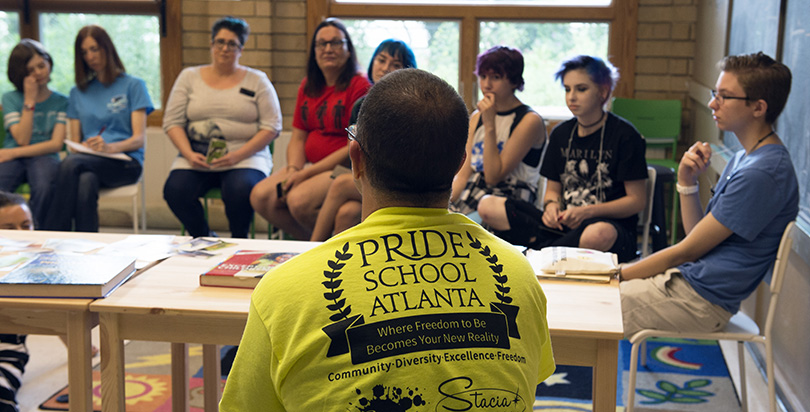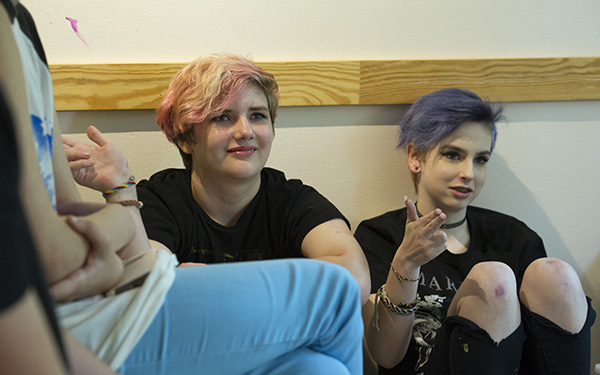Atlanta, Georgia
Christian Zsilavetz stood in front of the classroom reading the school’s handwritten guidelines from a spiral notebook to his eight students, ages 8 to 17.
It was the first meeting of teachers, students and volunteers in Atlanta’s recently launched Pride School, which is billing itself as the first school in the South aimed at creating a safe learning environment for LGBTQ teachers, students, their families and allies.
Reviewing the guidelines was one of eight items on the agenda that day. The first guideline, unsurprisingly, was “No bullying.” Then there was “Respect one another.” Third, “Use correct names and pronouns.”
So began the second week of the tiny private school’s educational experiment, founded on the premise of accepting students for who they are and guided by the principles of power-sharing and student-driven decision-making that gained traction during the counterculture free schools movement of the 1960s and ’70s.
The school hopes to turn around the alarming indicators for LGBTQ youth that have become more documented as the population becomes more visible, while providing a learning environment for these and other students that allows them to succeed.
At the same time, Zsilavetz points out that his school is casting a wide net, hoping to attract “gender-diverse or otherwise LGBT-identified students; students who come from LGBT families, regardless of how they identify; and families who just want a great place to go to school — where they’ll be accepted.”
Obstacles include not only the impacts of bullying and other challenges the school’s students faced in their previous schools but also the pushback from society at large, particularly in the Bible Belt. Georgia is one of 12 states to join Texas in a challenge to federal guidelines allowing public school students to use the restroom of their choice, and neighboring North Carolina is home to HB2, the controversial law that restricts use of public school and government restrooms and impedes local governments from passing anti-discrimination measures based on gender and sexual orientation.
The Pride school is one of only three such experiments nationwide, together with New York’s Harvey Milk High School and Milwaukee’s The Alliance School, both of which are public schools.
The dire situation facing lesbian, gay and bisexual students was demonstrated by the recently released Centers for Disease Control survey of 15,600 high school students that included questions for the first time about sexual-orientation identities. The survey, which did not ask students about being transgender, showed that about 1 in 12 students identified themselves as lesbian, gay or bisexual, and that these students were at greater risk than others.
Pride School students listen as the school’s mission and structure are discussed in the first days of school. (Photo courtesy Robin Rayne Nelson/ZUMA)
Forty percent had considered suicide in the past 12 months, and 29 percent had attempted to kill themselves; 34 percent were bullied at school, compared with 19 percent of the rest of the student population. About 1 in 8 had missed school in the past 30 days due to fears of violence.
The small group of students at Pride School, and their parents, are keenly aware of these issues, having lived them firsthand. Seventeen-year-old Jasper, who was born female but is questioning his gender, said a small group of like-minded friends in his former school warned him about “being ambushed or verbally harassed” by other students if he was open about his thoughts and feelings. “I also heard from my parents, who see all this stuff on social media — ‘Be careful, this could happen to you.’”
The hostility appears to be more acute in the South. The most recent biennial survey of about 7,900 sixth- through 12th-graders done by the Gay, Lesbian and Straight Education Network (GLSEN), a national education and advocacy group, shows, for example, that LGBTQ students were twice as likely to experience physical harassment and assault in the South as in the Northeast.
Zsilavetz hopes Pride School offers a better alternative to a sliver of these students and their families — and any others who could benefit from the school’s approach. The fledgling school has only eight students now; full annual tuition is $13,500, with need-based reductions offered in exchange for volunteering.
Zsilavetz said enrolling 12 to 15 students would make the school “financially viable,” and he is trying to raise scholarship money for families who can’t afford tuition. For now, the group size seems just right for the two rooms housing the project in a Unitarian church just off I-85, about eight miles northeast of downtown Atlanta. The church used to run a preschool program in the space, and much of the furniture — small tables, cubbyhole shelves — brings small children to mind.
The liberal nature of the denomination is a good fit for Pride School — the church recently placed gender-neutral signs on its restrooms.
“If you make these kids feel safe, then you can remediate the negative impact on learning”
Now 46, Zsilavetz has taught math since 1992 in public schools in New Jersey and Washington State. Schools suffer from a “don’t ask, don’t tell” approach to sexual and gender identity issues, he said. This winds up making day-to-day life in the classroom more difficult for teachers like Zsilavetz, who is transgender, and for students who are in any way outside society’s norms when it comes to gender and sexual orientation, he added.
“Most staff [in public schools] are not out,” Zsilavetz said. “In many states you can be fired [for being openly LGBTQ], and it’s relatively forbidden to talk [about it] with students.”
In the Pride School, students and staff are free to be themselves, he said.
Heather Stancil was volunteering at the school on a recent Tuesday. She and her child, Tristan, who is 17, decided to enroll in Pride after the teenager came out as a transgender male last summer. The private school Tristan attended in Alpharetta, Ga., required uniforms, including skirts for girls. Tristan “felt uncomfortable as a male” wearing the uniform, Stancil said.
The school had never dealt with an openly transgender student before, she added. “We didn’t want Tristan to be that much of a trailblazer,” Stancil said.
She and Tristan went to therapy together. Stancil and her husband learned about the risks for LGBTQ youth —the bullying, suicides and drugs.
“I was scared to death,” she said. “I wanted to do everything in my power to not have anyone harm my child … [and] being transgender paints an even bigger target on your back.”
They began homeschooling. Tristan didn’t feel motivated. “The whole year was a wash [academically],” Stancil said. “We were feeling lost.” Then she came across news of the Pride School online. “Everything just fell into place.”
Across a nearby table from Tristan, 17-year-old Jasper is glad he found the school as well. He went through public school in Alpharetta, a suburb about 25 miles north of Atlanta, where he remembers feeling “socially awkward.”
“I felt different but couldn’t put a finger on it,” said Jasper, who was born female. Then a friend in eighth grade talked to him about the “pride spectrum,” as he calls it. “I thought maybe I fell on that [spectrum].”
For the next two years, Jasper “expanded a network of friends to talk to” about his feelings. Finally, last spring, he told his parents. “I felt I wasn’t female. I wasn’t male … I told them, ‘I don’t want to go by my birth name anymore.’”
Gradually, his parents came to accept the new name and the questioning of his gender. But in school, he couldn’t be open. “Kids would say, ‘God says gay kids are going to hell,’” he recalls.
Finally, his mother found Pride School. “I can relate to these kids,” he said, sitting on a beanbag chair that occupies a central place in the classroom. “I can accept and love myself.”
Cary Costello is a director of the LGBT studies program and a sociology professor at the University of Wisconsin, Milwaukee. He is also the transgender parent of a daughter who graduated from the Alliance School, one of the other schools nationwide that is based on providing a safe place to learn for children who have been bullied. Nearly half the students are LGBT.
“If you make these kids feel safe, then you can remediate the negative impact on learning,” Costello said. “You allow them to focus on education instead of survival.”
Allan Laird, lead teacher at the Alliance School, said his students “come in broken and behind academically.” Founded in 2005, the school has seen students achieve increases in attendance and GPA, as well as decreases in violence. The charter high school has 195 students and a waiting list of several dozen. It features such innovative practices as staging student-led circles throughout the school at least four times a year to air any grievances or conflicts.
The school has gone “from being the black sheep to the cool older brother” in the education world during the past decade-plus, Laird said. National and international media have visited, and the Milwaukee school district has asked Laird to share the school’s techniques with principals.
The lead teacher wasn’t surprised to hear about Atlanta’s school. “I think the larger social changes [of recent years] help give people courage to start schools like Pride,” he said.
Like the Alliance School, Pride School seeks to innovate in its educational approach. Peter Gray, a research professor at Boston College, has for decades studied the free-school model Zsilavetz and the school’s board have adopted, particularly at the
Sudbury Valley School in Massachusetts.
The idea is to give students a central role in creating rules and guidelines for the school, and to mix students of different ages in classrooms. The result: “It turns out if adults provide a safe place for learning, you don’t have to require them [students] to learn … you can’t stop them from learning!” he said.
Opening a school that draws LGBTQ students is not without controversy. In the short time Pride School has been open, Zsilavetz has received online attacks, such as an email with the subject line “homo school” and the following message: “My kid’s a fag. Can I send him to your school?”
But he’s also been surprised at pushback from area LGBTQ activists, who have told him that opening the school “lets public schools off the hook … They say we’re not holding them accountable.”
Still, Mike Sadowski, author of the recently released book Safe Is Not Enough: Better Schools for LGBTQ Students, said that schools like Harvey Milk High School, the Alliance School and Pride School fill a need.
“Public schools are under an obligation to be safe and inclusive for LGBTQ students,” he said. “But until that’s happening, these schools serve a purpose. Students can benefit. Especially if an unsafe public school is the alternative.”



;)